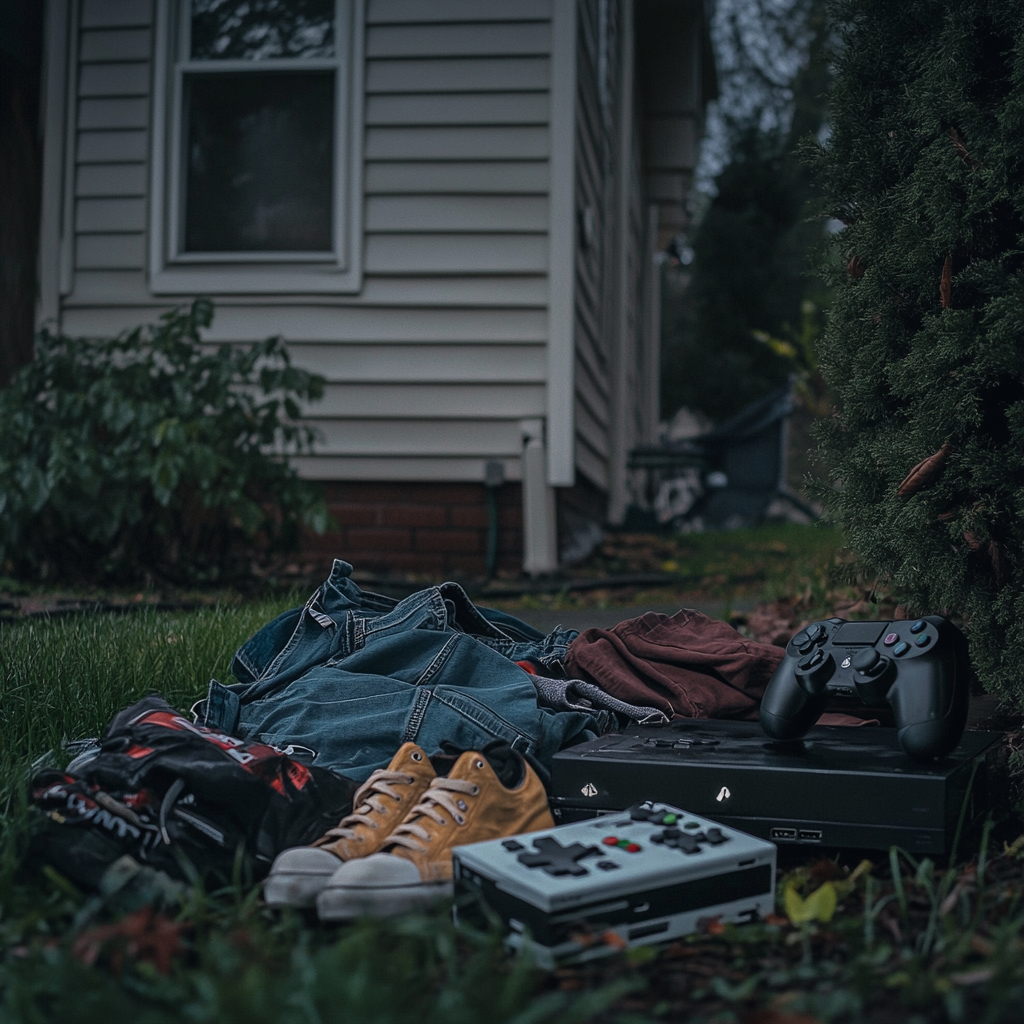
The morning had started like any other, tinged with the usual mix of hope and mild anxiety that came with an aging pet’s vet visit. Buffy, our sweet, silver-faced girl, was scheduled for a routine dental cleaning. We expected her to come home a little groggy, maybe missing a tooth or two, but otherwise, our same old Buffy.
But Dr. Mac, with her quiet wisdom and deep understanding of the creatures in her care, had a feeling. Before the anesthesia, she looked closer at Buffy’s recent lab work. The call came later that morning, a gentle voice delivering news that felt like a physical blow. Advanced kidney failure. Anesthesia was too risky; it could push her fragile system past the point of no return.
Suddenly, the simple dental cleaning faded into insignificance. A new, heartbreaking reality settled in. We looked at Buffy, still wagging her tail when we spoke her name, still nudging our hands for pets, and knew what we had to do. The kindest, most loving act was to let her go now, surrounded by love, before the illness stole her joy and her will to live. We couldn’t bear the thought of her suffering, losing her appetite, her spark dimming day by day.
My first thought was Robbie. He adored Buffy, and she him. This decision, this final act of love, had to include him. I left immediately to pick him up from school. The car ride felt heavy, the usual chatter replaced by the quiet hum of the engine and the weight of what was to come.
Gathering my courage, I explained to him, as gently and honestly as I could, that Buffy was very sick, that her body was tired, and that we needed to help her find peace. I told him she wouldn’t be coming home with us this time.
His eyes filled, but his voice was steady. “I want to hold her,” he said, his small voice firm. “I want to be the one holding her when she goes to heaven.”
My heart swelled with a painful mix of sorrow and profound pride. Of course. There was no one else I would rather give that honor to.
We drove home, the quiet returning, but now filled with a different kind of understanding. I looked at him, this young boy carrying such a heavy truth with such grace. “Robbie,” I started, my voice thick with emotion, “I am so incredibly proud of you. Proud that you understand how important it is to take care of our old animals, and that helping them means making sure they never, ever suffer.”
He just nodded, his gaze fixed somewhere beyond the windshield, already preparing himself for the difficult task ahead, for the final, loving embrace he would share with his dear friend Buffy as she journeyed home. And in that quiet moment, I knew that while our hearts were breaking, we were navigating this pain together, grounded in the deepest kind of love and compassion.
Eu peguei minha irmã flertando com meu marido no meu chuveiro enquanto eu estava em uma viagem de negócios — minha vingança fez os dois chorarem

Alguns segredos se escondem à vista de todos, esperando o momento certo para destruir tudo. Nunca pensei que seria pego no meio de um até o dia em que entrei em minha própria casa e vi meu mundo virado de cabeça para baixo.
Você acha que conhece as pessoas mais próximas de você, certo? Era nisso que eu costumava acreditar. Eu era o tipo de pessoa que confiava facilmente: meu marido, minha irmã, meu mundo inteiro. Mas a vida tem um jeito de te pegar de surpresa quando você menos espera, e de repente, você está vivendo uma história que você não desejaria nem para seu pior inimigo.

Uma mulher sentada em sua sala de estar | Fonte: Midjourney
Sou Greta, 30, gerente de marketing com um trabalho agitado que me faz viajar mais do que eu gostaria. Tom e eu estamos casados há cinco anos. Sempre fomos aquele casal que as pessoas dizem que “deve ser”. Você sabe, os namorados do ensino médio que perseveraram, construíram uma vida juntos e, de alguma forma, fizeram parecer fácil.
Então tem minha irmã, Kelly. Ela é dois anos mais nova, cheia de vida e sempre o centro das atenções. Se eu sou a rocha confiável, Kelly é a imprevisível explosiva. E até agora, eu sempre pensei que nos complementávamos perfeitamente.

Uma mulher rindo | Fonte: Midjourney
Então, semana passada, eu estava em uma viagem de negócios. Era só mais uma coisa típica de trabalho; reuniões intermináveis, jantares chiques e muita conversa fiada. No sexto dia, eu estava morrendo de saudades do Tom.
Então, pensei, por que não voltar para casa um dia mais cedo e surpreendê-lo? Imaginei esse momento perfeito em que ele ficaria todo animado em me ver, talvez teríamos um jantar tranquilo e então, bem… você entendeu a ideia.

Uma mesa decorada com velas para um jantar romântico | Fonte: Pexels
Entrei na garagem, praticamente zumbindo de excitação. Tirei os sapatos silenciosamente, querendo pegá-lo desprevenido. A casa estava estranhamente silenciosa, mas imaginei que Tom pudesse estar tirando uma soneca ou fazendo recados.
Eu andei pela sala de estar, e foi quando ouvi: o chuveiro ligado. Um sorriso surgiu no meu rosto. Momento perfeito, certo? Eu simplesmente pularia, e seria o reencontro romântico com o qual eu estava sonhando a semana toda.

Uma mulher retorna de uma viagem de negócios | Fonte: Midjourney
Mas conforme me aproximei, ouvi outra coisa. Uma voz. Uma voz de mulher. Meu coração começou a disparar, mas continuei me movendo, dizendo a mim mesma que não era nada — até que reconheci a voz. Kelly. Minha irmã. Na minha casa. Com meu marido.
Parei de repente, minha respiração presa na garganta. Então ouvi a voz de Kelly novamente, clara como o dia, “Querida, entre! Temos apenas mais alguns dias até ela voltar.”
Meu estômago se revirou. Era como se meu mundo inteiro tivesse acabado de se despedaçar em um segundo cruel.

Uma mulher chocada vestida com traje de negócios | Fonte: Midjourney
Eu podia sentir meu pulso batendo forte em meus ouvidos e minhas mãos tremendo. Eu queria irromper por aquela porta e gritar, confrontar os dois ali mesmo, encharcados e indefesos. Mas eu não fiz isso. Algo em mim simplesmente… estalou. E de repente, a raiva deu lugar a outra coisa, algo muito mais satisfatório.
Se eles quisessem jogar, eu também poderia jogar. E eu ia ganhar. Eu recuei, peguei minhas chaves e saí tão silenciosamente quanto entrei. Minhas mãos tremiam quando liguei o carro, minha cabeça zumbindo de raiva e descrença.

Uma mulher dirigindo um carro | Fonte: Midjourney
Quanto mais eu dirigia, mais claros meus pensamentos ficavam. Eu não iria simplesmente confrontá-los. Isso seria muito fácil, muito previsível. Eu iria fazê-los se arrepender de cada segundo dessa pequena aventura da maneira mais perfeita, humilhante e hilária possível.
Parei na loja mais próxima, peguei um carrinho e comecei a jogar tudo que eu precisaria para o meu plano. Eles mexeram com a mulher errada e, quando eu terminasse, eles desejariam nunca ter pisado na minha casa.

Um close de um carrinho de compras em um supermercado | Fonte: Unsplash
Primeiro passo do meu plano? Voltei para casa. Quando cheguei lá, Tom e Kelly estavam relaxando na sala de estar como se fossem donos do lugar.
Eu podia ouvir suas risadas, e isso fez minha pele arrepiar. Eu me esgueirei para dentro, mantendo-me nas bordas da sala para que eles não me notassem. Era difícil ficar quieto quando tudo o que eu queria fazer era gritar, mas eu mantive a calma.

Um casal rindo | Fonte: Midjourney
Depois disso, peguei alguns sacos de lixo e comecei a juntar todas as coisas do Tom: suas roupas, sapatos, seus amados consoles de videogame e até mesmo seu kit de barbear. Parecia que eu estava mudando-o de casa, mas esse não era exatamente o plano.
Depois que eu tinha tudo, carreguei meu carro e fui direto para a casa de Kelly. Eu joguei as coisas de Tom por todo o jardim da frente dela, certificando-me de que seu console favorito caísse de cara na grama. Eu respirei fundo, sentindo a onda de satisfação. Eu ainda não tinha terminado, mas esse era um bom começo.

Sapatos, roupas e consoles de videogame de um homem jogados no jardim da frente de uma casa | Fonte: Midjourney
Segundo passo: liguei para Sarah, nossa amiga em comum com um talento para o drama. Ela é do tipo que usaria um vestido de baile para uma festa de pizza só pela diversão. Se alguém pudesse ajudar a tornar esse plano espetacular, era ela.
“Sarah, você não vai acreditar no que aconteceu”, eu disse, com a voz trêmula de raiva e excitação.
“Greta, o que está acontecendo?” ela perguntou, imediatamente preocupada.

Uma mulher parece preocupada enquanto fala ao telefone | Fonte: Midjourney
Contei tudo a ela: o chuveiro, a traição, o despejo das coisas do Tom. Ela engasgou, então começou a rir tanto que teve que me colocar no viva-voz só para recuperar o fôlego.
“Meu Deus, Greta. Isso é loucura! O que você vai fazer?”
“Bem”, eu disse, sorrindo para a ideia se formando na minha cabeça, “estávamos planejando aquele churrasco no próximo fim de semana, certo? Que tal adiantarmos para amanhã? Mas este não é um churrasco qualquer; é uma festa de apresentação.”

Uma mulher sorri enquanto fala ao telefone | Fonte: Midjourney
Sarah estava dentro. Ela começou a mandar mensagens para as pessoas imediatamente e, em minutos, a lista de convidados havia dobrado. Estávamos transformando isso no evento do ano, e todos estavam prestes a testemunhar a grande revelação do segredinho de Tom e Kelly.
O terceiro passo foi o meu favorito. Criei um chat em grupo com amigos e familiares, incluindo Tom e Kelly, e enviei uma mensagem: “Notícias empolgantes! Venha para a casa da Sarah amanhã para uma grande surpresa! Código de vestimenta: clima de férias tropicais!”

Uma mulher enviando mensagens de texto em seu telefone | Fonte: Midjourney
No dia seguinte, o quintal estava cheio de pessoas com camisas floridas, óculos escuros e cores brilhantes, tomando coquetéis e imaginando qual seria a grande novidade. Eu assisti da lateral enquanto Tom e Kelly apareciam, ambos parecendo inquietos, provavelmente sentindo que algo estava errado.
“Ei, amor”, Tom disse, surpreso ao me ver. “Quando você voltou da sua viagem de negócios e do que se trata tudo isso?”
“Ah, você vai ver, hun”, respondi, dando a ele um sorriso doce. Kelly tentou evitar contato visual, mexendo na alça do vestido de verão. Eu podia dizer que ela estava nervosa, e era exatamente assim que eu queria que ela se sentisse.

Uma mulher parece nervosa enquanto está em uma festa | Fonte: Midjourney
Quando todos chegaram, bati meu copo para chamar a atenção deles. “Ei, pessoal! Obrigado por terem vindo em tão pouco tempo”, comecei. “Sei que vocês estão curiosos sobre a surpresa, e acreditem, é uma grande surpresa.”
Olhei para Tom e Kelly, seus rostos eram uma mistura de confusão e medo. Quase senti pena deles. Quase.
“Então, aqui está o acordo”, continuei. “Ontem, descobri que meu querido marido Tom e minha maravilhosa irmã Kelly estavam se esgueirando pelas minhas costas.”

Uma mulher falando em um microfone em uma festa | Fonte: Midjourney
Suspiros ecoaram pelo pátio, olhares alternando entre Tom, Kelly e eu.
“Mas não se preocupem, não estou bravo. Na verdade, estou grato. Porque toda essa confusão me aproximou de todos vocês e me fez perceber algo.”
Tom parecia ter levado um tapa. “Greta, espera—” ele começou, mas eu levantei minha mão.
“Ah, ainda não terminamos. Já que vocês dois amam surpresas, vamos fazer um joguinho hoje. Chama-se ‘Quem consegue fazer as malas mais rápido?’” Peguei duas malas que trouxe e joguei aos pés de Kelly e Tom.

Duas malas | Fonte: Freepik
“Você tem dez minutos para arrumar suas coisas e sair da minha vida. Quanto mais rápido você for, mais rápido você ganha.”
Houve um silêncio atordoado, então uma explosão de risadas de Sarah, rapidamente seguida por uma onda de risadas ao redor do grupo. O rosto de Tom ficou vermelho, sua boca abrindo e fechando como um peixe fora d’água. Kelly parecia querer desaparecer.
Tom tentou gaguejar algo, sua voz falhando. “Greta, por favor, não é o que parece, eu juro—”

Um homem parece envergonhado enquanto está em uma festa | Fonte: Midjourney
“Guarde isso, Tom,” eu o interrompi, braços cruzados. “As únicas palavras que eu quero ouvir de você são ‘adeus.’”
Kelly agarrou sua bolsa, lágrimas transbordando em seus olhos. “Isso é ridículo!” ela cuspiu, sua voz tremendo enquanto ela saía furiosa em direção ao portão.
Tom demorou-se, olhando para os nossos amigos, desesperado por alguém que o apoiasse. “Gente, vamos lá, isso é um mal-entendido—”
Sarah levantou seu copo com um sorriso irônico. “É melhor encontrar um novo lugar, Tom. Boa sorte!”

Uma mulher sorri enquanto segura um copo de bebida em uma festa | Fonte: Midjourney
Tom hesitou, seus ombros caíram em derrota. Ele finalmente se virou e seguiu Kelly para fora, seu rosto vermelho de vergonha. No final, metade dos nossos amigos estava me oferecendo bebidas, e a outra metade estava dizendo a Tom para descobrir sua situação de vida.
Nem preciso dizer que Tom não voltou para casa naquela noite. E Kelly? Bem, ela tem tentado evitar eventos familiares desde então. Eles pensaram que iriam me enganar, mas no final, eu ri por último.

Uma mulher confiante | Fonte: Midjourney
Dê uma olhada em outra narrativa emocionante: quando Maria planejou uma festa surpresa para o aniversário de 40 anos do marido, ela não esperava encontrar estranhos entrando pela porta em vez dele. A confusão chocante, envolvendo uma reserva inesperada no Airbnb, se transformou em uma noite inesquecível cheia de risadas e convidados inesperados.
Continue lendo a história clicando aqui.
Este trabalho é inspirado em eventos e pessoas reais, mas foi ficcionalizado para fins criativos. Nomes, personagens e detalhes foram alterados para proteger a privacidade e melhorar a narrativa. Qualquer semelhança com pessoas reais, vivas ou mortas, ou eventos reais é mera coincidência e não intencional do autor.
O autor e a editora não fazem nenhuma reivindicação quanto à precisão dos eventos ou à representação dos personagens e não são responsáveis por nenhuma interpretação errônea. Esta história é fornecida “como está”, e quaisquer opiniões expressas são as dos personagens e não refletem as opiniões do autor ou da editora.



Leave a Reply